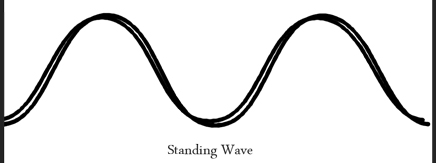Have you ever played bass guitar in a room and noticed that if you hold a particular note it will “boom” and grow louder and be louder than the others? Or maybe a particular low note of a guitar just seems louder than the others? This effect is caused by a standing wave. A standing wave is a buildup of acoustic waves at a particular frequency inside a room. The dimensions, size, shape and absorbent qualities of a room all determine what frequencies the standing waves will resonate. When mastering and album, or any phase of post-production for that matter, controlling these standing waves is absolutely essential.
Picture a sound wave; a smooth, rounded waveform that is bouncing between two parallel walls. In this case it will be a low G, which is approximately 98hz. The lower, audible notes have very long cycles (distance between the wave peaks). When our 98hz sound wave leaves it’s speaker at roughly 768 mph and bounces between parallel walls it will “line up” with it’s self, meaning the peaks of the waves are matching itself almost perfectly, see illustration 1.
The resulting effect of our 98hz sine wave “lining up” with itself is an artificial boost at this frequency, thus making this note a very big problem in our room. In a small room, such as a control room or listening environment you will usually have several frequencies that are “standing.” These standing waves are quite troublesome for mixing and mastering engineers. Unlike playing a single note on the bass guitar, frequencies in a mix, which are being amplified by the room, won’t be as obvious. It will just be a subtle increase at a particular frequency and thus an inaccurate playback.
I highly recommend locating these standing waves in your room prior to monitoring any mix. Below is a useful calculation tool:
http://www.macupdate.com/app/mac/18743/wave-length-calc
Contact Andrew Mitchell with any questions and/or comments:
andy@audiobaymastering.com



Comments are closed.